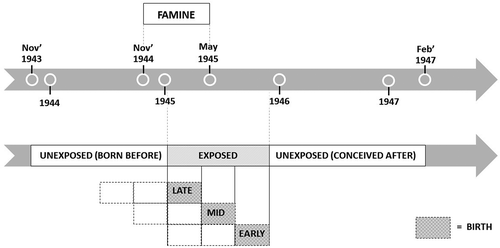The Dutch Famine Birth Cohort
Lessons learned from 25 years of research into long-term consequences of prenatal exposure to the 1944-1945 Dutch famine
Journal: International Journal of Environmental Health Research
Date: May 2021
The Dutch famine, also known as the Dutch Hunger Winter, occurred in The Netherlands at the end of World War II. The Nazis had cut off food supplies to the western part of The Netherlands in retaliation for the exiled Dutch government supporting the Allies. Some twenty thousand people died and 4.5 million were affected by the direct and indirect consequences of the famine, which took place from November 1944 through May 1945. In addition to an exceptionally harsh winter, bad crops, and four years of brutal war, the population was forced to live on rations of 400-800 calories per day. People had to eat grass and tulip bulbs to survive.
This article reports on the lessons learned from 25 years of research into the long-term health effects the famine has had on those who were in utero during the time it occurred. This group is called the Dutch Famine Birth Cohort. Studies have also focused on the children of this cohort, and their grandchildren.
Several factors allowed researchers to study the effects of this tragic event in great detail:
- There was a sudden onset and rapid relief from the famine (well defined time period).
- It was imposed on a previously well-nourished population.
- Food availability was registered accurately throughout the famine.
- Midwives and doctors continued to provide obstetric care and kept detailed medical records throughout the famine, some of which have been kept for decades – allowing long-term, follow-up studies.
Summary
Prenatal exposure to the famine had permanent effects on health outcomes that emerged later in life among the offspring. People who were in utero during the famine suffered a variety of physical and mental health issues as adults. The two main lessons reported out in this journal article were:
1) There were effects of prenatal famine exposure in the absence of effects on body size at birth. In other words, in spite of adaptations that enable the fetus to grow to a normal size during famine, undernutrition still had adverse, long-term health consequences.
2) The effects of undernutrition in the womb depended on the timing of when organs and systems were developing.
- The effects on health later in life were most pronounced among those exposed to famine in early gestation. This may not be surprising considering the fact that all organs are laid down in early pregnancy. An insufficient food supply in early gestation interferes with basic organ development.
- Exposure to famine in mid gestation was linked to an increase in micro-albuminuria in adulthood (an early sign of vascular disease) and a decrease in creatinine clearance (waste filtered from the blood by the kidneys and excreted in urine). These are both factors that signify an elevated risk for heart and kidney disease. Mid gestation is when the number of filtering units (nephrons) in the kidney rapidly increase, and exposure to famine in mid-gestation prevented robust kidney development. Mid gestation is also the time when lungs are developing and the bronchial tree grows most rapidly. Those exposed to famine in mid gestation had an increased prevalence of obstructive airways disease. Studies of the Dutch hunger winter provide another layer of evidence that undernutrition in the womb permanently affects the structure and physiology of the lungs and kidneys.
Other findings (not exhaustive)
- Males and females exposed at any stage in utero put them at higher risk for type 2 diabetes and heart disease.
- Exposed females grew up to have more children, give birth to twins more often, be less likely to remain childless and start having children at a younger age than unexposed females.
- Females exposed in early gestation had an increased prevalence of breast cancer, higher cardiovascular mortality, cancer mortality and breast cancer mortality.
- At age 63, women (but not men) exposed to the famine in early gestation had an overall higher mortality rate compared to unexposed 63-year-old women.
- Children whose mothers were in utero during the famine were heavier at birth, while those whose fathers were exposed in utero were heavier in adult life – suggesting different epigenetic influences according to the sex of the parent.
- At age 58, both men and women exposed to famine in early gestation had poorer cognitive function.
- Males exposed to famine in early gestation had a higher risk for neurodegenerative diseases.
- Males exposed to famine in early gestation reported more symptoms of anxiety and depression.
Key takeaways/Why this is important:
This paper provides a long-term view of the consequences of undernutrition during pregnancy by studying the effects of the Dutch famine for decades. The findings can be used to provide guidance on preventive strategies and remedial actions today. The authors argue we should prioritize a more equal distribution of food across the world so that the consequences of poor diets due to both undernutrition and overnutrition will be prevented, and that priority should be given to women of reproductive age. Based on the findings presented in this review, the authors expect that adequately feeding women before and during pregnancy will allow future generations to reach their potential and lead healthier and more productive lives - ultimately leading to a healthier and more equitable future.

Back to main research brief page
The OHSU Bob and Charlee Moore Institute for Nutrition & Wellness supports human research that seeks to find the links between maternal stresses, including poor nutrition, and elevated disease risks for babies as they become adolescents and adults.
________________________________________________________________________________________________________________________
De Rooij, SR, Bleker, LS, Painter, RC, Ravelli, AC, & Roseboom, TJ (2021). Lessons learned from 25 Years of Research into Long term Consequences of Prenatal Exposure to the Dutch famine 1944–45: The Dutch famine Birth Cohort. International Journal of Environmental Health Research, Retrieved online DOI: 10.1080/09603123.2021.1888894